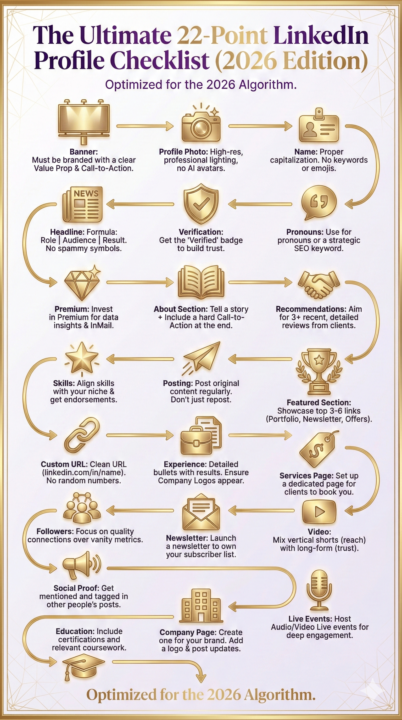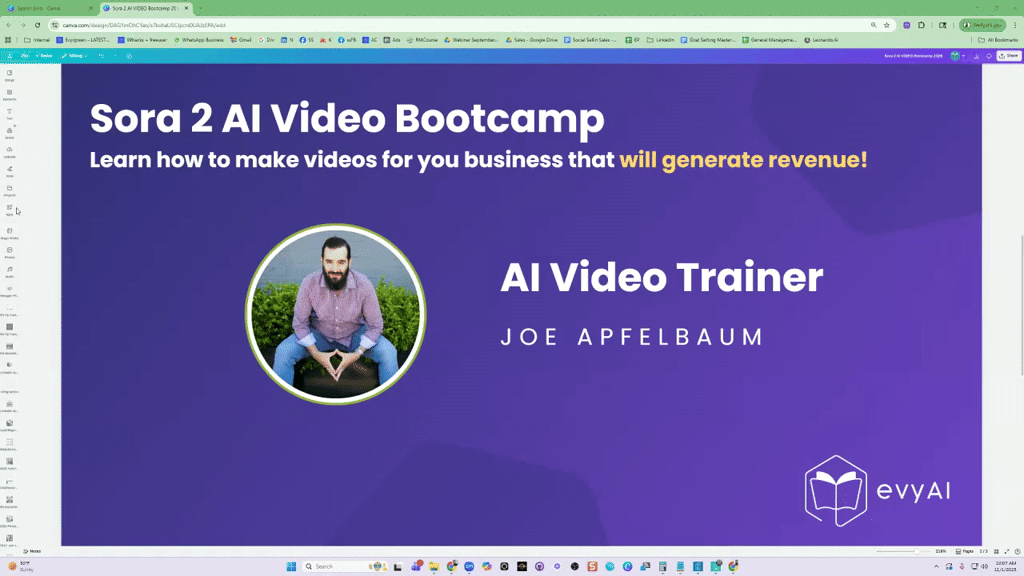Happy Chanukah!! Image Prompt
What are you doing to celebrate? Im giving out gifts... PROMPT: Professional headshot style photo of a smiling man with a beard holding a sign that reads 'Happy Chanukah' in bold letters. He's wearing a casual button-down shirt in a warm yet professional color (light purple or warm brown). Background is a soft-focused winter scene with golden hour lighting witha big Menorah with 8 candles lit, doughnuts, dreidles, start of davids, the works in the background. The man has an energetic, genuine smile and is looking directly at camera. The sign is held at chest level. Natural lighting, high quality, professional photography style, shallow depth of field.

Need an inforgraphic for your business?
Here is an example infographic prompt that we used to create our own infographic.. we can create these types of prompts for you along with the infographics if you want see examples at strategy.evyai.com/infographics THE FLYWHEEL EFFECT INFOGRAPHIC - DETAILED DESIGN PROMPT Title: "The $1M+ Flywheel: How All Three Levers Create Exponential Growth" Dimensions: 1200px × 2400px (vertical scroll format for LinkedIn/web) Assessment URL: strategy.evyai.com/3levers COLOR PALETTE (evyAI Brand) Primary Colors: - Deep Purple: #4a1a66 - Medium Purple: #6b2d8f - Primary Gold: #d4af37 - Bright Gold: #f4d03f Secondary Colors: - Light Purple Background: #f0e6f6 - Very Light Purple: #f8f4fb - Pale Gold: #fff9e6 - White: #FFFFFF - Dark Purple Text: #2d1a3d Accent Colors: - Success Green: #4CAF50 - Warning Orange: #FF9800 - Multiplier Badge: Gradient from #d4af37 to #f4d03f HEADER SECTION (0-300px from top) Background: - Gradient background: Linear gradient from #6b2d8f (top) to #4a1a66 (bottom) Title (positioned 40px from top, centered): - Text: "The $1M+ Flywheel Effect" - Font: Montserrat Bold - Size: 52px - Color: #FFFFFF - Letter-spacing: -0.5px Subtitle (positioned 110px from top, centered): - Text: "Why All Three Levers Together = 10x Results (Not Just 3x)" - Font: Montserrat Medium - Size: 24px - Color: #f4d03f (gold) - Letter-spacing: 0px Tagline (positioned 150px from top, centered): - Text: "Each lever amplifies the others. Here's the math." - Font: Open Sans Regular - Size: 18px - Color: #FFFFFF - Opacity: 90% Decorative Elements: - Small circular motion lines around the title (white, 20% opacity) - Subtle gear/cog icons in corners (white, 15% opacity) MAIN FLYWHEEL DIAGRAM (300-1200px from top) Background: - Solid white (#FFFFFF) - Subtle radial gradient emanating from center (very light purple #f8f4fb at edges)

Do you have these 30 images yet? Image prompts for professionals for nano banana in evyAI
Here are 30 detailed Picsart AI Nanobana prompts for professional business photos: 1. The Executive Headshot Create a professional corporate headshot using the attached image. The subject should be wearing a navy blue blazer with a crisp white shirt, positioned against a soft gray gradient background. Use natural, diffused lighting from a 45-degree angle to create subtle shadows that add dimension to the face. The camera angle should be straight-on at eye level with a shallow depth of field, creating a blurred background while keeping the face sharp and in focus. The overall mood should be confident, approachable, and polished, suitable for a LinkedIn profile or company website. 2. The Confident Office Portrait Transform the attached image into a professional portrait set in a modern office environment. The subject should wear a charcoal gray suit with a light blue shirt, standing with arms crossed confidently near a window. Utilize soft natural window light coming from the left side, supplemented with subtle fill light to eliminate harsh shadows. The background should show a tastefully blurred modern office with glass walls and contemporary furniture. Shoot from a slight low angle to convey authority and confidence, with a medium depth of field that keeps the subject sharp while the office background remains recognizably professional but softly out of focus. 3. The Approachable Consultant Generate a warm, approachable business portrait using the attached image. Dress the subject in smart casual attire—a well-fitted button-down shirt in light gray with sleeves rolled to the elbows, no jacket. Position them leaning casually against a clean white brick wall with soft afternoon sunlight creating a warm glow. Use three-point lighting with a key light at 45 degrees, fill light to soften shadows, and a subtle backlight to separate the subject from the background. The camera should be at chest height, angled slightly upward to create an inviting, personable feel. Maintain a shallow depth of field to keep focus on the face while the textured brick wall provides visual interest without distraction.
Infographic Generation Prompts for Nano Banana
Here are some ideas for PROMPTS that will make infographics with Nano Banana Business & Professional @Lori Osborne @Elisa Boogaerts @Peter Bemko 1. Company Timeline Visualization "Create an infographic showing the evolution of [company/product name] from inception to present day, using a minimalist timeline design with key milestones highlighted in bold colors" 2. Sales Funnel Breakdown "Design a vertical infographic illustrating a complete sales funnel with conversion percentages at each stage, using gradient colors from warm to cool tones" 3. Team Organizational Chart "Generate an infographic displaying our team structure as an interconnected network diagram, with role-specific icons and a modern corporate color scheme" 4. ROI Calculator Visual "Create a step-by-step infographic showing how to calculate ROI for [specific investment], with numbered sections and clean financial graphics" 5. Project Management Framework "Design an infographic explaining the Agile methodology using geometric shapes, flow arrows, and a professional blue-and-orange palette" Educational & Learning @Deborah Kaminetzky @Barbara Harrington @Virginia Muzquiz 6. Historical Event Timeline "Create an infographic mapping out the major events of [historical period], styled as an ancient scroll with illustrated landmarks and dates" 7. Scientific Process Diagram "Generate a detailed infographic explaining the process of photosynthesis, using botanical illustrations and earth-tone colors" 8. Language Learning Roadmap "Design an infographic showing the journey from beginner to fluent in [language], with milestone markers and cultural icons" 9. Mathematical Concept Visualization "Create an infographic breaking down [complex math concept] into simple visual steps, using geometric patterns and contrasting colors" 10. Study Technique Comparison "Generate a side-by-side infographic comparing 5 different study methods with effectiveness ratings and visual metaphors"

How to switch from the OLD sora platform to the new Sora 2 platform
Confused about switching between Old Sora and the new Sora 2 Social Network? I just created a complete walkthrough that breaks down EVERYTHING you need to know. 📍 SWITCHING FROM NEW SORA → OLD SORA 1. Go to Sora.com 2. Click the three dots on the bottom left 3. Select "Switch to Old Sora" What you get with Old Sora: ✅ Full prompting capabilities ✅ Choose 1 or 2 videos at once ✅ Duration control (5, 10, 15, or 20 seconds) ✅ Multiple resolution options ✅ Aspect ratio customization ✅ Video OR image generation ✅ Built-in presets library ✅ Storyboard feature ✅ Advanced creation tools 📍 SWITCHING TO NEW SORA 2 (Social Network) 1. Look at the bottom right corner of Old Sora 2. Click "Open New Sora" What you get with Sora 2: - Clean social feed interface - Simple creation: Describe video + Duration + Orientation - Image upload option - Feed filters (Top creators, Latest, Most Popular) - Search function (find creators like @SamAltman or @JoeApplebaum) - Discover what others are creating Note: Sora 2 has fewer creation options but is designed for social discovery and sharing! 🎓 EXCLUSIVE: SORA 2 AI VIDEO BOOTCAMP You can learn more about the Sora 2 Bootcamp here. https://strategy.evyai.com/sora2bootcamp It starts Nov 3rd at 2pm EST. We are almost sold out. You can watch the replay of our webinar on that page as well as get a special deal on the bootcamp. 📅 Sunday, November 3rd⏰ 2-6 PM EST🎯 4-Hour LIVE Training What's Included: ✨ 9-module complete course ✨ Step-by-step Sora setup & Cameo configuration ✨ 100+ video ideas & prompts ✨ Chrome extensions & hacks ✨ Special resources library ✨ Previous 2-hour webinar replay 👉 Go to Classroom → "Sora 2 AI Video Bootcamp" to access everything now! The full bootcamp replay will be available right after our live session on Sunday. 🎥 [WATCH THE FULL WALKTHROUGH HERE]

1-30 of 143

skool.com/evyai
Join the AI for LinkedIn community to connect with like minded LinkedIn users who want to network and grow their presence on LinkedIn with evyAI.com
Powered by






